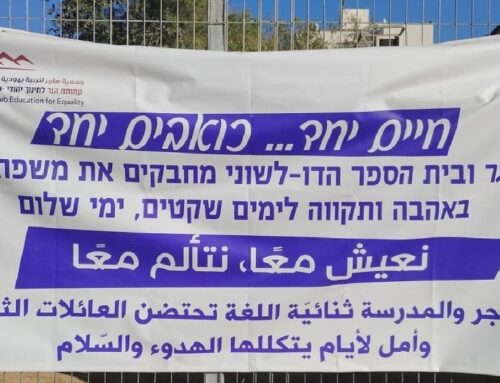It’s election time again in Israel, and, once more, time for Israeli political polls to help strengthen Israeli Jewish prejudices towards Israel’s Palestinian Arab citizens. If you thought that public opinion polls only glean, analyze and report on political trends, well think again.
Take a look, for example, at the results of the Smith Institute poll commissioned and reported on last week by the Jerusalem Post: Kadima 34-35 [seats]; Labor: 18; Likud: 17-18; Israel Beitenu: 9-10; National Union / NRP: 9-10; Shas: 9-10; Arab parties: 9-10; United Torah Judaism: 5-6; Meretz: 4-5.
Notice anything funny? Try the third to the last party listing – “Arab parties”. Now, the last time I checked, there is no party running for elections known as “Arab parties”. There are, however, three major election slates currently running for Knesset that draw the vast majority of their support from the Israeli Palestinian Arab citizenry. They are Hadash, Balad, and the two-party alliance of United Arab List-Arab Renewal Movement (UAL-ARM). The competition between them (personal and political) is fierce, and the ideological gaps distinguishing them are significant – so much so that these parties were unable to unite in a joint slate for the upcoming elections, even though the recently raised vote threshold for entering the Knesset (2%) threatens to leave one or more of them without representation.
But you’d never know any of this looking at some of the polls. The average, casual reader looking at this Smith Poll would naturally conclude: “Oh, there must be a bunch of Arab parties, and they’re basically all the same”. A natural extension of this line of thought is: “Oh, I guess the Israeli Arabs are all the same”, which is a close cousin of “all Arabs are all the same”, and its sidekick, “all the Arabs want to throw the Jews into the sea”.
Imagine if a poll failed to distinguish between Shas and United Torah Judaism, and just lumped them together as “those ultra-orthodox parties”. But why stop there, why not throw Kadima, Labor, Likud, Meretz and all the others into the mix, and just report the poll results for the “Jewish parties” vs. the “Arab parties”?
I’m personally not sure who’s to blame here. Are the pollsters not recording the specific preferences of (predominantly Arab) voters when they reply “Balad” or “Hadash” or “UAL-ARM”? Somehow, I find that hard to believe. But if the pollsters are doing their job, then it must be the media outlets that either do not care, or do not think their readers care, to differentiate. And it’s not just the Jerusalem Post. While the HaAretz/Channel 10/Dialog poll recognizes Hadash, Balad and UAL-ARM as individual parties, the polls as reported by the newspaper giants, Yediot Aharonot (Dahaf poll) and Maariv (Teleseker poll), do not. Neither does the IDF Radio website (Geocartographia poll).
Is this a trivial matter? I think not. Prejudice comes in all forms, and sometimes the prejudice found in subtext is more dangerous than the kind found in outright bigotry. An open call by an Israeli fringe-rightist to deny Arab citizens their civil rights would arouse immediate opposition of the Israeli mainstream; unfortunately, the use of language that homogenizes and “monolithizes” some 20% of all Israeli citizens seems to fly under the radar, unnoticed, while it shapes, poll by poll, the political consciousness (or perhaps sub-consciousness) of Israel’s Jewish majority.






Interesting point, Ron. This also reflects discussion of the “Jewish majority,” referring to the idea that a simple majority in the Knesset might be composed of a minority of the Jews combined with most or all of the Arab Knesset member’s votes. According to this calculation, a majority of Jews in Israel, could find themselves among the minority of Israelis.
I don’t know about the specific polls you mentioned, but it is often the case that polllsters skip over calling Arab communities and estimate their electoral potential, then indicate that a poll is of the adult Jewish population.
You go, Ron!
I think it’s a mostly innocent — but destructive — mistake similar to thinking that “All Asians look alike”.
A friend of mine has published a number of fine cognitive studies under the rubric “face and race”, using computer-generated faces on a continuum from African-American to Caucasian. In-group people are much better at discriminating among same-race faces than out-group people — but, minorities are better at discriminating among majority faces than vice-versa.
So, destructive though it may be, I think the dynamic at play is largely unconscious. Sadly, this means that people are likely to be rather defensive in response to arguments such as yours, because they were only relying on their cognitive heuristics, which from their point of view are fully intact.
-Eran